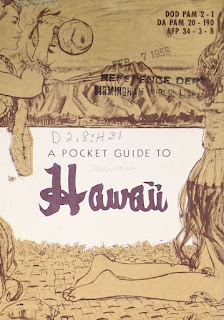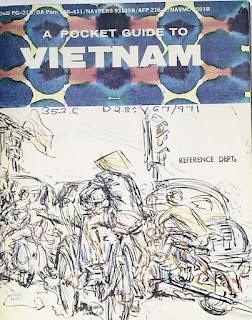Department of Defense Pocket Guides
by Mary Beth Newbill, Head of Government Documents and Southern History Department

American soldiers deployed overseas would often find themselves in countries that were unfamiliar to them and whose history and customs they had no knowledge of. In order to help service men and women become more comfortable in their new homes, the Department of Defense published a series of "pocket guides." Measuring 5 ½" x 4 ¼", these little guides are packed with information.
The library has about 40 of these pocket guides and they can be found in the Government Documents Department. The collection includes guides from Alaska and Hawaii that were published in 1956, three years before both territories were granted statehood. Especially interesting is the guide for Vietnam, published in 1971 when the Vietnam War was far from being resolved. Other guides include Germany, Italy, Greece, French Morocco, the Middle East, Korea, and the Arctic, to name a few.
Mostly published in the 1950s through the 1980s, each guide presents the soldier with a surprisingly detailed history of the country of their deployment and includes helpful advice about the country's economy, society, religion, and government. Always respectful in tone, the guides emphasize the people of each country. Most of them go into great detail about family life and social customs. They even include instructions on what to do if invited into someone's home (always remove your shoes if invited into a home in Okinawa and offer enthusiastic and detailed compliments when invited to a Moroccan home). All of the guides include a section with common phrases and their pronunciations. Even the guide to the United Kingdom includes a British to American vocabulary with definitions for British terms such as chips, lorry, and zed (French fries, truck, and the letter "z," respectively).
Not only is the factual information found in the pocket guides interesting, they also provide us with a look at the manners and social customs that were the norm for each country at the time the guide was published. By including such information, we are able to learn what our soldiers were taught and how they were expected to behave while representing the United States on foreign soil.

American soldiers deployed overseas would often find themselves in countries that were unfamiliar to them and whose history and customs they had no knowledge of. In order to help service men and women become more comfortable in their new homes, the Department of Defense published a series of "pocket guides." Measuring 5 ½" x 4 ¼", these little guides are packed with information.
The library has about 40 of these pocket guides and they can be found in the Government Documents Department. The collection includes guides from Alaska and Hawaii that were published in 1956, three years before both territories were granted statehood. Especially interesting is the guide for Vietnam, published in 1971 when the Vietnam War was far from being resolved. Other guides include Germany, Italy, Greece, French Morocco, the Middle East, Korea, and the Arctic, to name a few.
Mostly published in the 1950s through the 1980s, each guide presents the soldier with a surprisingly detailed history of the country of their deployment and includes helpful advice about the country's economy, society, religion, and government. Always respectful in tone, the guides emphasize the people of each country. Most of them go into great detail about family life and social customs. They even include instructions on what to do if invited into someone's home (always remove your shoes if invited into a home in Okinawa and offer enthusiastic and detailed compliments when invited to a Moroccan home). All of the guides include a section with common phrases and their pronunciations. Even the guide to the United Kingdom includes a British to American vocabulary with definitions for British terms such as chips, lorry, and zed (French fries, truck, and the letter "z," respectively).
Not only is the factual information found in the pocket guides interesting, they also provide us with a look at the manners and social customs that were the norm for each country at the time the guide was published. By including such information, we are able to learn what our soldiers were taught and how they were expected to behave while representing the United States on foreign soil.



Comments